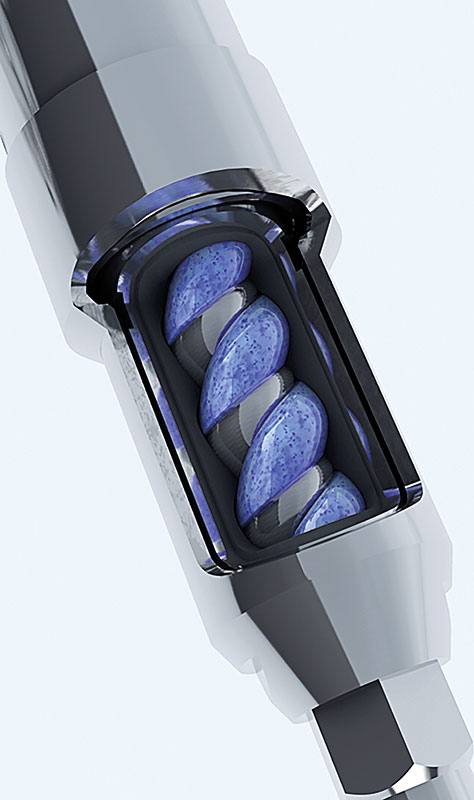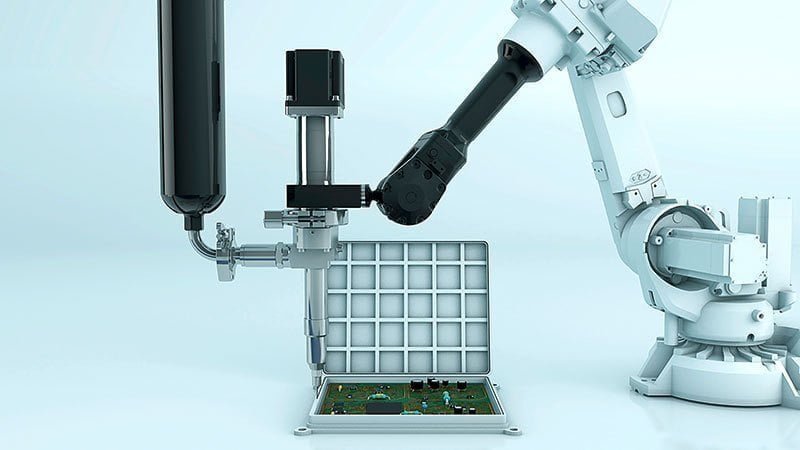Dosing tasks appear to be easy – at first glance. Adhesives, silicones, sealants … the automated application of various viscous materials has been used for decades. So, where’s the problem? Only an optimal combination of several influencing factors guarantees a perfect dosing process with repeatable results.
Challenges in dosing tasks

ViscoTec endless piston principle
The automated application of various viscous materials should, on the one hand, provide as much flexibility as possible for the selection of the suitable dosing material and, on the other hand, enable uncomplicated processing through maximum process reliability.
How should the dosage equipment be designed for high-viscosity, abrasive and shear-sensitive fluids to be processed reliably and at the same time be able to tolerate changes in the flow behavior of these fluids? The progressive cavity technology combines the ability to feed the material with low wear, as well as low friction, thereby achieving a long life and very high energy efficiency.
The perfect combination: Know-how and technology
ViscoTec dispensers offer the technology of the endless piston principle with their progressive cavity pump and its continuous non-stop dosing of the desired flow rate. High repeatability is achieved by volumetric feeding. The rotation of the eccentric rotor is possible both forwards and backwards and therefore offers a programmable retraction for a defined thread breakage without dripping. This high precision, with a dosing accuracy of ≥ 99%, is also achieved by the defined flow rate volume in the individual dispensing chambers, which transports abrasive, shear-sensitive or highly filled materials without them being affected.

Dosing task: Application of abrasive thermal paste
Progressive cavity pumps are ideally suited for pressure-sensitive fluids, containing polymeric hollow spheres for example, but also for viscosity-independent applications with fluids of up to several million mPas or thixotropic materials. 2-component applications with mixing ratios of up to 100:1, or even materials with a low pot life, can be processed without difficulty and dosed directly as required.
Perfect preparation of the dosing application is achieved by a direct and gentle emptying of the material and a constant supply also by means of progressive cavity pumps. Fluids which require a pretreatment can be fed into a material buffer for homogenization and degassing. The dosing process is optimally planned from the emptying of the container via the treatment unit or the material buffer up to the actual dosing of the material and adapted to the respective application – for the highest process stability and cost control.
ViscoTec Pumpen- u. Dosiertechnik has been involved with rheology and, in particular the flow behavior of highly viscous fluids, for 20 years. The close cooperation with material manufacturers facilitates a constant exchange of data and facts concerning new developments and their effects on the dosing process.
Let us take a closer look at the three main dosing applications in the electronics industry: the potting with filled silicones or polymers, the application of thermal pastes with a very high proportion of fillers and the bonding of components by means of adhesives. Many of the dosing materials used here include fillers which in turn alter the specific properties of the material – thermal conductivity, surface hardness, electrical insulation, UV resistance, curing or gelling time, or thixotropy. The fluids are usually highly abrasive due to the filler. In a dosing application, the user expects a low-friction system, which has no effect on wear and resulting costs. The interaction of surfaces in relative motion (dosing pump) and their environment (dosing material) can be observed in mechanical, physical and chemical reactions. The effect of the mechanical energy on the fillers or solids contained in the fluids, is to be kept as low as possible without impairing the desired dosage result. The combination of rotor and stator with defined feeding chambers in the ViscoTec dispensers support the gentle transport of the abrasive components. The ViscoTec stators consist of continually developed elastomers and have outstanding properties compared to other polymers, such as good wear and chemical resistance.
Dosing applications and influencing factors
Important parameters determine the dosing process: a short cycle operation, cyclic application or continuous operation, low to high viscosity / structurally sensitive / solids-laden fluids, tribological losses such as friction / leakage / wear / aging / contact geometry. The suitable dosing pump will take into account all known variables and be adjusted to the material. In addition, chemical reactions can occur which produce wear such as plastic deformation, abrasion, adhesive friction and fracture mechanics. The optimal design of the dosing components for abrasive or chemically aggressive fluids is often obtained from preliminary tests and defined qualification levels.
Continuous optimization of the dosing pumps to maintain and improve the service life of dosing components accompanies the increasing and changing requirements of the ever more complex materials on the market. Development work is primarily carried out in material research: in terms of resistance to chemicals and wear, as well as in functional construction. As part of its continuous series of tests, ViscoTec Pumpen- u. Dosiertechnik has dosed a highly aggressive thermal paste in a total of 1,500 dosing cycles and 80 hours of cycle operation, with more than one ton of gap filler being dosed with the progressive cavity pump. The material was fed from a 200-liter barrel using the ViscoMT-L emptying system, and the 160 ml dispensing shots were dosed with the 3VMP22 dispenser. The test was carried out under a constant dosing pressure of 20 bar on two tested elastomer compounds from the ViscoTec portfolio. Before and after this series of tests, the wear of the stators was measured based on the dimensional deviation. The average deviation was only 0.45% – a very positive result that far exceeded the expectations of the material manufacturer. The progressive cavity pump therefore allows high service life of the dosing components for improved energy efficiency and reduced repair and maintenance expenses.
A further example is the use of the 3RD10 dispenser within a dosing application in 3-shift operation over a period of 9 months. The highly filled copper solder paste on a glycol basis with a density of approximately 4.0 g / cm³ was used in a fully automatic filling system. The field trial subjected the dispenser to a constant load for 7 days per week and 24 hours of operation per day. In order to greatly reduce the flow rate of the material and therefore the friction of the particles contained therein, the dispenser was operated at 30% of the maximum speed. The measurement of the stator used at the end of the trial compared to the initial stage showed a deviation of only 0.04 mm from the setpoint – a perfectly positive result. In addition, no wear marks could be found on the stainless steel rotor component.
Tested elastomers for the stator component and the combination with a stainless steel rotor showed the lowest shear during a trial for the processing of the solder paste. The low-pulsation feed as well as the low pressure counteract a partial filler concentration. An even volume flow in the endless piston dispenser prevents sedimentation. The danger of applying an inhomogeneous solder paste was therefore completely avoided. A successful “Stresstest” for the Dispenser!
Engineering & Consulting
Each well-functioning dosing application begins with expert consultation and carefully considered decisions. The process requirements and the dosing material must be defined. The appropriate dosage components are selected and the correct application parameters determined. In laboratory tests, the dosage applications are simulated and all parameters checked and optimized again – a validation is given. The results from such tests are easily transferable into the application situation for the integration of the dosing task into the overall process.
A positive collaboration between the customer, the material manufacturer and the dosing technology enable the qualification of suitable solutions from the material selection to the implementation in the dosing process. The comprehensive consultation leads to a consistent development of a highly reproducible dosing application to increase production rates and process safety – with complete cost control.
Meet us at the Bondexpo in Stuttgart, Germany – 09. – 12. October and convince yourself.
The post Sensitive dosing tasks? Highly viscous, abrasive, shear-sensitive? appeared first on ViscoTec Pumpen- u. Dosiertechnik GmbH.

